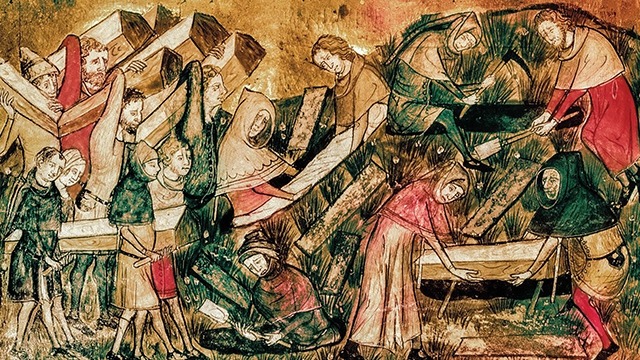Great World Pandemics: The Black Death & Georgia
As the world continues to experience deep effects (death rate; economic downturn, slowdown of globalization) of the novel coronavirus, we are looking at various global pandemics which affected Georgia.
The Black Death is mostly associated with the appearance of the Mongols on the world stage in the early 13th century. Surprisingly, the disease in Europe most likely spread from the Crimea peninsula when Mongol leader Khan Janibeg besieged Caffa (nowadays Feodosya) in 1346. Since the town served as a crucial commercial city with contacts with Italian cities of that age, a quick spread of the infection was guaranteed. As one contemporary, Gabriel de’ Mussi, relates, the infection spread among the Mongol troops, and Janibeg deliberately catapulted infected bodies over the city walls of Caffa. This effectively marked the first real use of biological warfare.
The name “Black Death” originated from the specifics of the disease itself, as the infection usually turned the skin a black color, with such symptoms as fever and joint pains.
The psychological impact from the spread of the infection in Europe was immense. For instance, Giovanni Boccaccio in his famous book ‘Decameron’ (1348) described the symptoms of the plague the following manner:
“…in men and women alike it first betrayed itself by the emergence of certain tumors in the groin or armpits, some of which grew as large as a common apple, others as an egg, some more, some less, which the common folk called gavocciolo. From the two said parts of the body, this deadly gavocciolo soon began to propagate and spread itself in all directions indifferently; after which the form of the malady began to change, black spots or livid making their appearance in many cases on the arm or the thigh or elsewhere...“
The Italian chronicler, Agnolo di Tura del Grasso, who also happened to be a contemporary to the events and experienced the event firsthand as he lost his wife during the pandemic, mentioned that an infected person initially experienced symptoms similar to flu. Later on there was a “swell beneath their armpits and in their groins.” There were two ways to contract the infection: one was through an insect bite and another airborne. In both cases, the infected usually lived no more than 3-4 days.
Also interesting, particularly in light of current events unfolding across the world, is another passage recounted by Boccaccio where the author describes what we nowadays call ‘social distancing’:
“Tedious were it to recount how citizen avoided citizen, how among neighbors was scarce found any that showed fellow-feeling for another, how kinsfolk held aloof, and never met, or but rarely; enough that this sore affliction entered so deep into the minds of men and women that in the horror thereof, brother was forsaken by brother, nephew by uncle, brother by sister, and oftentimes husband by wife: nay, what is more, and scarcely to be believed, fathers and mothers were found to abandon their own children, untended, unvisited, to their fate, as if they had been strangers.”
As stated, Caffa had close trade relations with the Mediterranean world, which conditioned the fast spread of the disease. However, it is also believed that because of Caffa’s commercial contacts with the Georgian world, namely Sebastopolis (modern Sokhumi), the Black Death also entered Georgia.
Indeed, it is recorded that the spread of infection took place during the reign of David IX (1346-1360), confirmed by a note dated 1348 in which ‘great death’ (most likely ‘Black Death’) is mentioned.
According to Georgian historian Prince Vakhushti Batonishvili, the pandemic endured long after the reign of David IX. It is also reported that the epidemic was so widespread during Bagrat V (1360-1393) that even the queen died, along with many others. The infection was recurrent, accelerating and abating its spread over the following centuries.
According to existent sources, the impact of the Black Death on the European mainland was more profound than in the South Caucasus. A geographically closed off Georgia in the 14th century seems to have fared relatively well in comparison with the commercially interconnected Europe, where obliteration of nearly 1/3 of the population (some think about as much as ½ of the entire populace) took place.
By Emil Avdaliani
Black Death At Tournai, 1349, Le Muisit, Gilles (1272–1352) /Bibliothèque Royale De Belgique, Brussels/Bridgeman Images












